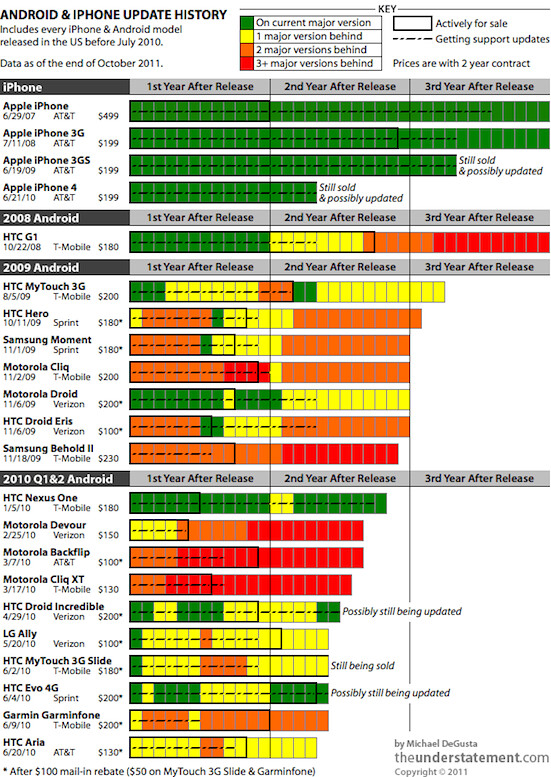Say what you will about the Android vs. iPhone debate, but there’s simply no denying that the chart below is pretty jarring. Stainpakingly compiled by Michael DeGusta of The Understatement, the chart maps out the update history of various Android devices and iPhones.
A common problem that has plagued Android devices is that not all models are upgradable to the latest OS. Sometimes carriers stand in the way and sometimes a particular device’s hardware just isn’t up to snuff. In contrast, the iPhone, going all the way back to the original, was able to run the current version of iOS even 3 years after debuting. Curiously, some Android devices are even 2 major OS versions behind when they’re released!

DeGusta writes:
Other than the original G1 and MyTouch, virtually all of the millions of phones represented by this chart are still under contract today. If you thought that entitled you to some support, think again:
- 7 of the 18 Android phones never ran a current version of the OS.
- 12 of 18 only ran a current version of the OS for a matter of weeks or less.
- 10 of 18 were at least two major versions behind well within their two year contract period.
- 11 of 18 stopped getting any support updates less than a year after release.
- 13 of 18 stopped getting any support updates before they even stopped selling the device or very shortly thereafter.
- 15 of 18 don’t run Gingerbread, which shipped in December 2010.
- In a few weeks, when Ice Cream Sandwich comes out, every device on here will be another major version behind.
- At least 16 of 18 will almost certainly never get Ice Cream Sandwich.
In Google’s zeal to get Android everywhere, they are sacrificing usability and hamper Android users’ ability to enjoy the latest and greatest the Android OS has to offer.
The difference here between Google and Apple could not be any more stark. Google is preoccupied with getting Android into as many people’s hands as possible, and if that means some users will be using an antiquated version of Android, well that’s just the cost of doing business. Apple, on the other hand, puts the user experience first and foremost. It would never occur to them to continue selling iPhone devices that could only run extremely old versions of iOS.
From security issues to the quality of apps developers will write for Android, the chart above really crystalizes the inherent problems of Android.
In other words, Apple’s way of getting you to buy a new phone is to make you really happy with your current one, whereas apparently Android phone makers think they can get you to buy a new phone by making you really unhappy with your current one.
DeGusta has much more detailed analysis on his research over here. It’s very insightful and definitely worth poring over.





Tue, Nov 8, 2011
Analysis, Featured, News